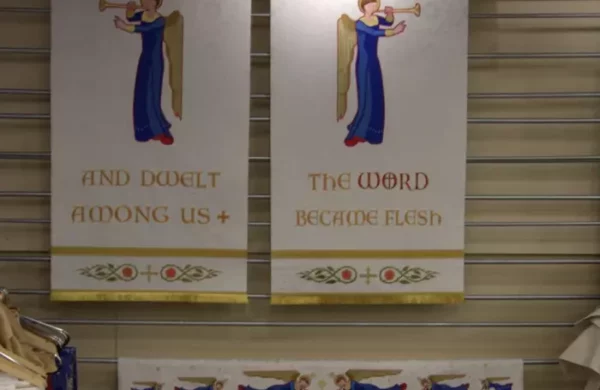
Martin The Mannequin _ Episode 3
In the snowy studio, a house elf named Timothy surprises Martin, the mannequin. Offering help with vestment repairs, Timothy shares his lineage connected to Jeanne Lanvin’s fashion house in Paris. While fixing stoles, Timothy directs Martin to return quick ship vestments and take the cat, Nightingale, back to the Arbor Boutique. Martin, intrigued by Timothy’s tales, heads out into the winter storm.
Like this:
Like Loading...

Ecclesiastical Sewing introduces new Chasuble patterns with fancy trims called orphrey bands. The blog explains orphrey bands’ history and talks about the special St. Hubert Brocatelle fabric. It shows how to choose trims and cut the fabric to make these beautiful church vestments, making the process easy to understand for everyone.
Like this:
Like Loading...
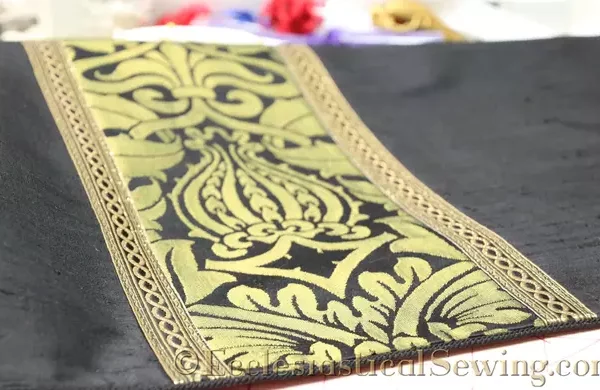
The Saint Augustine Chalice Veil is made from Silk Dupioni, which is a great option for black vestments used on Good Friday. Silk Dupioni is a good fabric choice for church vestment making because it looks rich, has a natural sheen, and a depth of color. Combining a solid fabric with a patterned orphrey allows the vestment to be visible from more than the first few rows of church pews.
Like this:
Like Loading...

The amice is the first garment to be put on by a priest. It is worn on the head, while he offers up prayers and intercessions, and then he continues to dress. After the alb is put on, the amice is pushed off his head and worn around his neck as a collar. The long cords of the amice are then tied around the alb under the arms, crossed around the back, and brought back to the front to be tied. All this being said, there are instances when the amice is kept upon the head for practical reasons: such as warmth during a processional or in a particularly drafty church.
Like this:
Like Loading...

Pugin was a famous designer of churches and all of the needed furnishings in England in the early 1800s. He sadly died at the age of forty. But he has left a legacy of beautiful liturgical art. Pugin designed many items, including some stunning vestments. Today, the Victoria and Albert Museum houses a collection of his vestments.
Like this:
Like Loading...
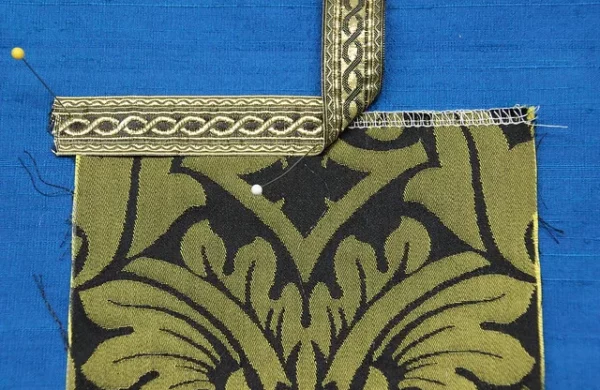
Sewing galloon trim to orphrey bands for pastoral stoles. Pre-make orphrey bands by pinning galloon trim to the base fabric before stitching. Ensure the surged edge is halfway up the trim to avoid fraying. Use an even feed foot on the sewing machine to prevent puckering. Stitch close to the galloon edge, back-stitching at the start and end. Repeat for each orphrey piece, maintaining even stitching. Check the position of the fourth piece to ensure alignment. This method reduces puckers and ensures a polished look for your pastoral stole. Happy sewing!
Like this:
Like Loading...
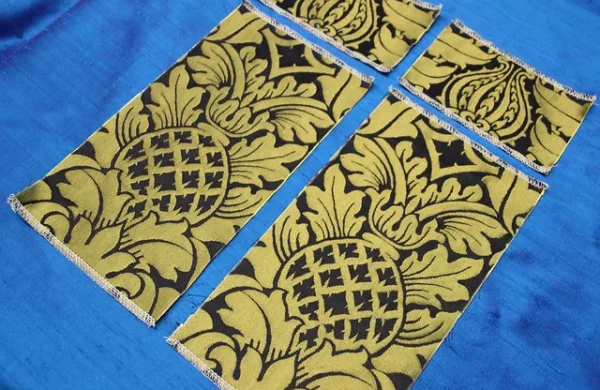
The St. Benet Black/gold trim is an excellent choice for either colored stole, as is the Black Dice trim, or the Gold St. Paul Braid.
Like this:
Like Loading...
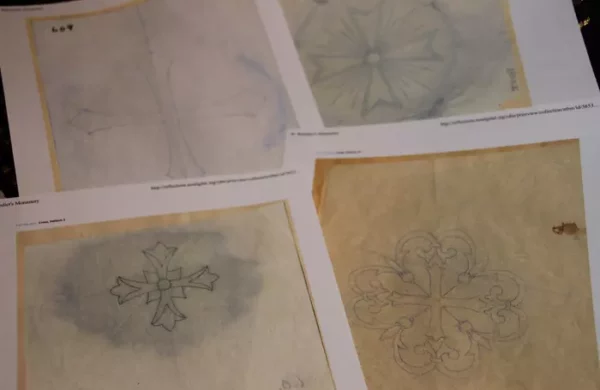
Fairford brocade offers two motifs: a pineapple and an ogee design. Choose the pineapple for the lower band and align it within selected cutting lines. Ensure minimal waste and use the ogee design for upper orphrey bands. Draw cutting lines with tailor’s chalk once satisfied with the design. Cut the motifs carefully, considering future usability of small fabric pieces.
Like this:
Like Loading...
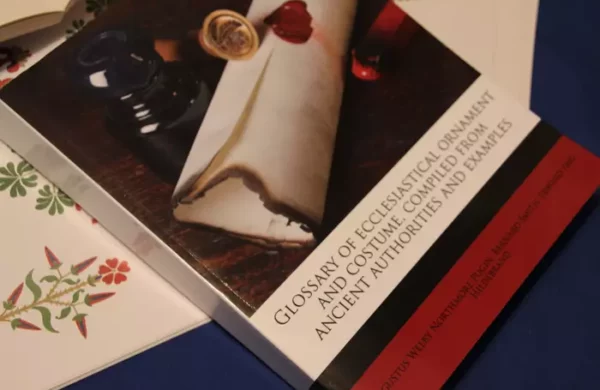
Glossary of Ecclesiastical Ornament, Augustus Pugin refers to ornamented garments of this type worn by ancient Romans as auriclavae or clavatae. Tunics were ornamented with a band referred to as a clavus or clavi. The bands, which were often purple in color, were sewn onto tunics.
Like this:
Like Loading...
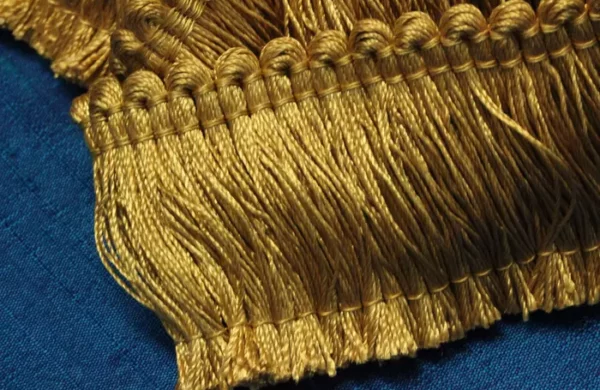
The fringe is a group of yarn, bundled together and held in place with several rows of stitching at the top edge. The lower edge has a chain stitch which holds all of the cut ends in place until the fringe is applied.
Like this:
Like Loading...
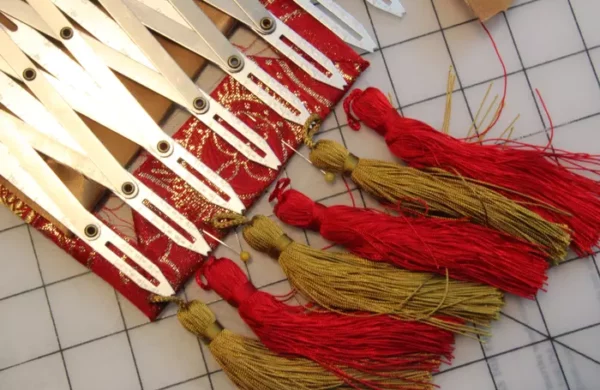
Tassels and fringe make excellent finishes for stole ends, but there are tricks for both. For tassels, use a button-hole marker to ensure even spacing. Decide on the number of tassels and the desired distance from each end, then mark and pin them in place. Tassels have a small cord or loop at the upper edge; attach it evenly. Tack the cord on the back of the stole, ensuring even hanging. In the photo, gold rayon blend tassels were initially used but later replaced with metallic gold tassels.
Like this:
Like Loading...
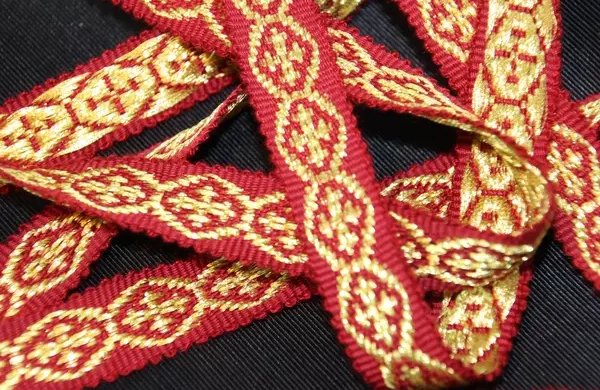
Dice Trim,” has tiny alternating squares woven in a solid color and a gold thread. This trim, although narrow at 1/2″, is a powerhouse of a trim, it gives a clean, tailored look. It sews very nicely. It comes in a nice assortment of liturgical colors: black, red, green, blue, gold, white, and purple. Dice Braid offers a very clean, tailored, crisp finish to vestments. It can be used to edge the long sides of stoles or as an end finish to a stole. It can be used as a finish on the edge of a chalice veil, as well as being used on any other type of vestment where trim is needed.
Like this:
Like Loading...
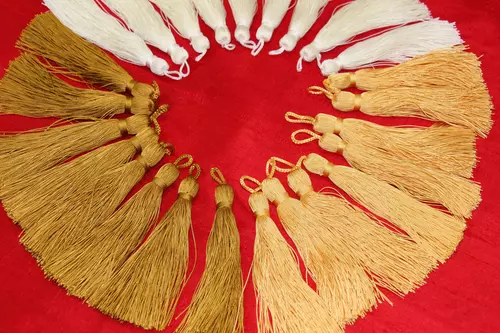
The end can have fringe on the lower edge, or the edge can have a plain hem as the finish. Creative placement of trims and orphrey bands offer other options. One of my favorite ways to finish the end of a stole is to use tassels. The tassel choices for this current stole project are a soft white or cream tassel and a gold tassel.
Like this:
Like Loading...

The orphrey trim for the chalice veil had been planned and cut to size and position based on the use of the black Passion Cross. The idea was to place the black motif on a gold motif so it would be more visible. The center of the orphrey was located and matched to the center of the design on the black Fairford Fabric.
Like this:
Like Loading...
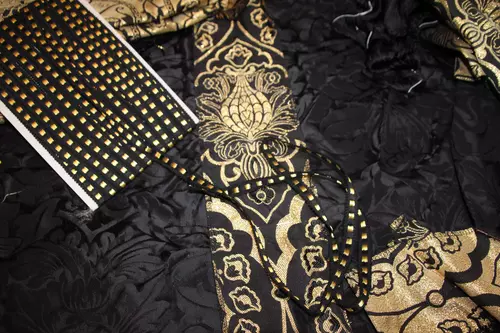
The Passion Cross – Church Symbolism by F.R. Webber
– This is a cross whose ends are cut to points. It is also known as the Cross Urdee, and the Cross Champain, sometimes the Cross Pointed. It represents the sufferings of our Lord and has been called by some authorities the Cross of Suffering. If pictured as rising out of a chalice, it represents our Lord’s agony in the Garden of Gethsemane. It may be used as a symbol of Maundy Thursday, or of Good Friday.
Like this:
Like Loading...
















You must be logged in to post a comment.